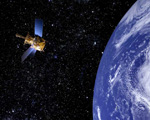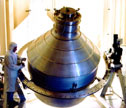WEEKLY UPDATE FOR 16 SEPTEMBER 2005:
GRAVITY PROBE B MISSION STATUS AT A GLANCE

| Item | Current Status |
| Mission Elapsed Time | 514 days (73 weeks/16.85 months) |
IOC Phase |
129 days (4.2 months) |
Science Phase |
352 days (11.6 months) |
Final Calibration Phase |
33 days |
| Current Orbit # | 7,586 as of 5:30 PM PST |
| Spacecraft General Health | Good |
| Roll Rate | Normal at 0.4898 rpm (122.5 seconds per revolution) |
| Gyro Suspension System (GSS) | All 4 gyros digitally suspended |
| Dewar Temperature | Not Available |
| Global Positioning System (GPS) lock | Greater than 99.8% |
| Attitude & Translation Control (ATC) | X-axis attitude error: 137.8 marcs rms (as of 9/15) |
| Command & Data Handling (CDH) | B-side (backup) computer in control Multi-bit errors (MBE): 0 Single-bit errors (SBE): Not Available |
| Telescope Readout (TRE) | Nominal |
| SQUID Readouts (SRE) | Nominal |
| Gyro #1 rotor potential | +2.7 mV (as of 9/13) |
| Gyro #2 rotor potential | +2.5 mV (as of 9/13) |
| Gyro #3 rotor potential | +1.2 mV (as of 9/13) |
| Gyro #4 rotor potential | +3.4 mV (as of 9/13) |
| Gyro #1 Drag-free Status | Backup Drag-free mode (OFF during some calibration tests) |
MISSION DIRECTOR'S SUMMARY
As of Mission Day 514, the Gravity Probe B vehicle and payload are in good health, with all subsystems performing nominally. We still have helium remaining in the Dewar, and the spacecraft is currently flying drag-free around Gyro #1.

The helium in the Dewar has now surpassed its estimated lifetime by more than two weeks. We have thus continued working our way through a prioritized list of calibration tests. Most of these tests have involved slewing the telescope (and spacecraft) to “visit” stars (both real and virtual) in the neighborhood around the guide star, IM Pegasi. In each case, we visit a neighboring location for a period of time and then lock back onto IM Pegasi for a number of hours. The purpose of these excursions to neighboring stars is to precisely calibrate the torques imparted onto the science gyroscopes by purposely misaligning the telescope axis (and spacecraft roll axis) by varying amounts from the direction of the gyros' spin axes.
Last Friday, we visited a virtual star (place where no stars visible to the telescope exist) located 0.1 degrees west of our guide star, IM Pegasi, in the direction of neighboring star HR Pegasi. We remained fixed on that virtual star location for 48 hours and then returned to IM Pegasi, where we remained for 24 hours.

While locked onto IM Pegasi, we switched drag-free control from gyro #1 to gyro #3 in order to perform some calibration tests on gyro #1. During this calibration test, the pressure in the Dewar dropped, and the spacecraft experienced thruster instability in the z-axis direction (along the spacecraft/telescope roll axis). This behavior was similar to instabilities that we had previously seen in June 2004, during the Initialization and Orbit Checkout (IOC) phase of the mission. The root cause is under investigation, but there is some speculation that this may be the result of a micrometeorite striking the spacecraft. To rectify this situation, we switched the operating mode of our micro thrusters to “open loop”--that is, turning off the thruster pressure sensors and relying instead on pre-defined thruster calibration curves to control thruster flow. We will leave the micro thrusters in open loop mode until the helium is depleted.



Last Tuesday, 13 Septmber, we visited the very bright (magnitude 2.45) neighboring star Alpha Pegasi (also known as Markab or HD 218045), located about 3.25 degrees south of IM Pegasi. We remained locked on Alpha Pegasi for 12 hours. Upon returning to returning to IM Pegasi, we switched drag-free control back to gyro #1.
Then, last Wednesday, we sent commands to the spacecraft to decrease its roll rate from 0.7742 rpm (77.5 seconds per revolution) to 0.4898 rpm (122.5 seconds per revolution). This resulted in some interference with a SQUID calibration signal, and the frequency of the calibration signal was subsequently changed, eliminating this issue. The spacecraft has since been performing nominally at the slower roll rate.

Finally, today, we initiated procedures to de-flux the SQUIDS---that is, removing electromagnetic flux from the SQUIDs by heating them up a few kelvins, and then allowing them to cool back down to their normal cryogenic operating temperature of 1.8 kelvin. Assuming that we still have helium remaining this weekend and next week, this process is a prelude to performing several gyro housing exploration tests, to be followed by a switch from backup to primary drag-free mode.
GP-B MISSION NEWS—RUNNING ON EMPTY AND VISITING THE BRIGHTEST STAR IN THE CONSTELLATION PEGASUS
If you drive a car, you have likely experienced—at least once—the situation where the needle on your car's gas gage moves into the red zone, and the light comes on indicating that the gas tank is nearly empty. But, unless you've been in this situation a few times with any particular car, you don't know for sure how much farther you can drive before the engine finally sputters and stops running. This is essentially the situation with our GP-B spacecraft right now. We know that we're in the “red zone” with our helium very nearly depleted, but how many more orbits will actually be sustained is basically anyone's guess.


And so, continuing our prioritized calibration tests, last week we visited the star Alpha Pegasi (aka Markab/HD 218045/ HR 8781), located about 3.25 degrees southward of IM Pegasi. Alpha Pegasi is one of the defining stars in the constellation Pegasus, the flying horse. It is approximately 110 light years away, and its luminosity is about 95 times greater than our Sun. In fact, the designation of “Alpha” Pegasi means that it is the brightest star in the constellation Pegasus. The set of composite photos from the Palomar Observatory Sky Surveys (POSSI and POSSII) to the right, clearly shows the comparative luminosity or brightness of Alpha Pegasi, Zeta Pegasi, HR Pegasi, IM Pegasi, and HD 216635—all the stars in the neighborhood of IM Pegasi that we have visited recently.
Following are some excerpts from Burnham's Celestial Handbook (a three-volume compendium of astronomical information), about Alpha Pegasi:
The name Markab or Marchab, is from the Arabian word for saddle, though the term might also refer to a ship. Other Arabic names were Matn al Faras, the Horse's Shoulder, and Yed Alpheras, the Horse's Forearm or Hand.
…Pegasus is, of course, the famed Flying Horse of Greek Mythology, one of the most curious, but also one of the loveliest concepts created by the ancient myth-makers of the Greek world. In the legend, he was born from the blood of the Medusa, when that monster had been slain by Perseus, and his name, it is thought, comes from the Greek 'Pegae,' the Springs of the Ocean' at the place of his birth.

…Pegasus was tamed by Athena or Minerva according to Greek legend, and given to the Muses, in whose service he became the symbol of poetic inspiration; in another tradition, he carried the thunder and lightning for Zeus.
In the sky, Pegasus appears turned over on his back with his body outlined by the Great Square (Alpha, Beta, and Gamma Pegasi, along with the Alpha of Andromeda.) His front legs are marked by Eta and Iota Pegasi, and his head by Epsilon Pegasi; the great wings are not clearly indicated, but would lie more or less at the position of the 'Circlet of Pisces,' some 10 degrees below the southern edge of the Great Square.

At this time of year in North America, the constellation Pegasus is clearly visible above the eastern horizon during the evening hours, as shown in the sky chart to the right.
As we noted last week, as long as we still have helium in the Dewar, we will continue working our way through our prioritized list of calibration tests. When the helium actually does run out, we will post a notice on our Web site and send out a message to the subscribers of our GP-B Update email list. NASA will also issue a news release, and we will then post the content of that release on our Web site and send it to our email subscribers.
UPDATED NASA/GP-B FACT SHEET AVAILABLE FOR DOWNLOADING
We recently updated our NASA Factsheet on the GP-B mission and experiment. You'll now find this 6-page document (Adobe Acrobat PDF format) listed as the last navigation link under "What is GP-B" in the upper left corner of this Web page. You can also click here to download a copy.
Drawings & Photos: The layered composite photo of the GP-B spacecraft orbiting Earth was created by GP-B Public Affairs Coordinator, Bob Kahn, using Adobe Photoshop and Adobe Illustrator. The photo of the Dewar was taken by Lockheed Martin photographer Russ Underwood. The photos of the micro thrusters and SQUID are from the GP-B Image Archive here at Stanford. The photos of the GP-B Mission Operations Center (MOC) were taken by GP-B Public Affairs Coordinator, Bob Kahn. The sky chart images, showing the guide star IM Pegasi and its neighboring stars, were generated by the Voyager III Sky Simulator from Carina Software. The star photos, as well as much of the information about these stars came from the various Web pages of the Centre de Donnees astronomiques de Starsbourg--CDS, including the Simbad astronomical database and the Aladin interactive sky atlas. Click on the thumbnails to view these images at full size.
MORE LINKS ON RECENT TOPICS
- Track the satellite in the sky
- Photo, video & and news links
- Build a paper model of the GP-B Spacecraft
- Following the mission online
- Our mailing list—receive the weekly highlights via email
- The GP-B Launch Companion in Adobe Acrobat PDF format. Please note: this file is 1.6 MB, so it may take awhile to download if you have a slow Internet connection.
Previous Highlight
Index of Highlights
